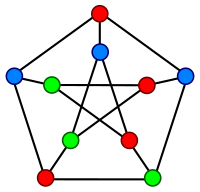
Photo from wikipedia
Let $n,r,k\in \mathbb{N}$ . An $r$ -colouring of the vertices of a regular $n$ -gon is any mapping $\unicode[STIX]{x1D712}:\mathbb{Z}_{n}\rightarrow \{1,2,\ldots ,r\}$ . Two colourings are equivalent if one of them… Click to show full abstract
Let $n,r,k\in \mathbb{N}$ . An $r$ -colouring of the vertices of a regular $n$ -gon is any mapping $\unicode[STIX]{x1D712}:\mathbb{Z}_{n}\rightarrow \{1,2,\ldots ,r\}$ . Two colourings are equivalent if one of them can be obtained from another by a rotation of the polygon. An $r$ -ary necklace of length $n$ is an equivalence class of $r$ -colourings of $\mathbb{Z}_{n}$ . We say that a colouring is $k$ -alternating if all $k$ consecutive vertices have pairwise distinct colours. We compute the smallest number $r$ for which there exists a $k$ -alternating $r$ -colouring of $\mathbb{Z}_{n}$ and we count, for any $r$ , 2-alternating $r$ -colourings of $\mathbb{Z}_{n}$ and 2-alternating $r$ -ary necklaces of length $n$ .
Journal Title: Bulletin of the Australian Mathematical Society
Year Published: 2019
Link to full text (if available)
Share on Social Media: Sign Up to like & get
recommendations!